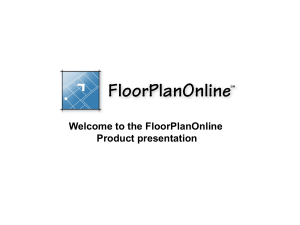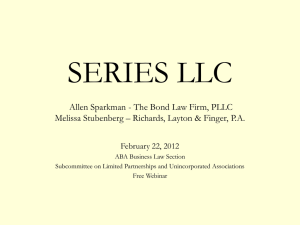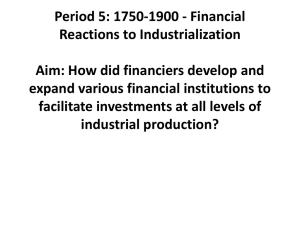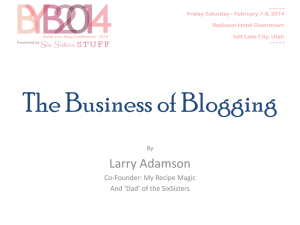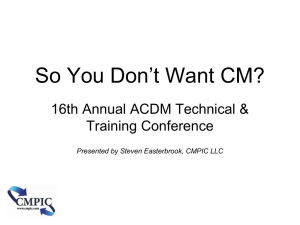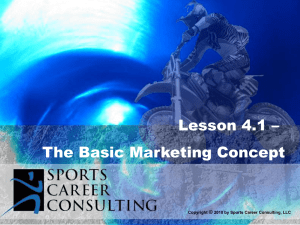Managing Organizational Change
advertisement
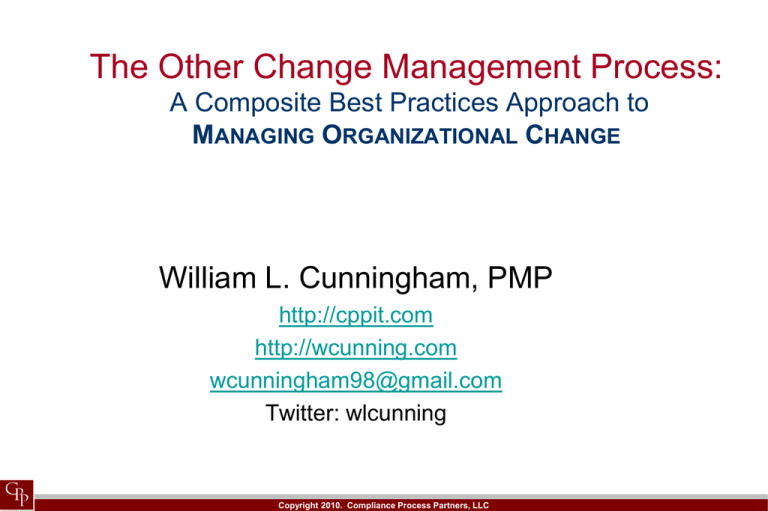
The Other Change Management Process: A Composite Best Practices Approach to MANAGING ORGANIZATIONAL CHANGE William L. Cunningham, PMP http://cppit.com http://wcunning.com wcunningham98@gmail.com Twitter: wlcunning Copyright 2010. Compliance Process Partners, LLC Contact: wcunningham98@gmail.com http://wcunning.com Twitter: wlcunning Presentation with notes available at http://www.wcunning.com/DMM/DMMHome.html Copyright 2010. Compliance Process Partners, LLC Agenda • Introductions • Difficulties of Managing Organizational Change • Composite Model to Building a Learning Organization • Questions Copyright 2010. Compliance Process Partners, LLC 5 Copyright 2010. Compliance Process Partners, LLC Homeostasis Homeostasis: the property of a system that regulates its internal environment and tends to maintain a stable, constant condition. Copyright 2010. Compliance Process Partners, LLC 7 Homeostasis Homeostasis: the property of a system that regulates its internal environment and tends to maintain a stable, constant condition. Time (Delay) Copyright 2010. Compliance Process Partners, LLC 8 The Fifth Discipline – Systems Thinking • Self-regulating systems have feedback loops – they respond to a control mechanism that monitors the system and seeks to return it to baseline. • There is often a delay between stimulus and the acting of the feedback loop – a delay between stimulus and response if you will. • While this balancing effect has positive origins— homeostasis works to keep things the same- even if they aren’t very good. Copyright 2010. Compliance Process Partners, LLC 9 The ‘System’ of Psychology It takes 21 days to embed new behaviors and make them habits. We are defined by our habits - Aristotle When undertaking your New Year’s Resolutions the best advice is to anticipate the inevitable back-slide – it’s just homeostasis at work… Copyright 2010. Compliance Process Partners, LLC 10 Psychology and Organizational Change • Organizations are comprised of individuals • You cannot change ‘organizational behavior’ – Only the behavior of individuals can change – (and you can’t change it…) • So, individual psychology – and individual homeostasis- will have to be accounted for in our project plans Copyright 2010. Compliance Process Partners, LLC 11 Organizations as Systems Copyright 2010. Compliance Process Partners, LLC 12 Copyright 2010. Compliance Process Partners, LLC 13 Copyright 2010. Compliance Process Partners, LLC The J-Curve of Change Initial level of happiness and productivity. Trough of despair Copyright 2010. Compliance Process Partners, LLC Happiness & Productivity JJ J Time Copyright 2010. Compliance Process Partners, LLC Copyright 2010. Compliance Process Partners, LLC Reasons for Failure of Organizational Change Initiatives • Difficulty changing the culture of the organization • Lack of staff commitment and understanding • Lack of education, communication and training • Responsibility without sufficient authority • Lack of effective ‘Champions’ • Loss of momentum after opening hype • Lack of funding Source – Pink Elephant (mostly) Copyright 2010. Compliance Process Partners, LLC Reasons for Failure of Organizational Change Initiatives • Lack of quantifiable long term benefits (ROI) • Lack of organizational learning (lessons learned – lack of iterative culture) • Satisfaction with status quo • Over-focus on tactical, isolated solutions rather than a strategic solution • Trying to do everything at once – over ambitious Source – Pink Elephant (mostly) Copyright 2010. Compliance Process Partners, LLC Reasons for Failure of Organizational Change Initiatives • No accountability; lack of clear ownership • Tools unable to support processes • People not skilled enough to support processes • No structured Project Management Source – Pink Elephant (mostly) Copyright 2010. Compliance Process Partners, LLC • Serious organizational change takes 3-5 years – This does not mean you can’t have quick wins • You must be prepared for resistance to any significant organizational change. • You must also understand that change adoption is not likely to be linear. Copyright 2010. Compliance Process Partners, LLC Peter M. Senge – The Five Disciplines (towards building a Learning Organization) • • • • • 1. Personal Mastery 2. Mental Models 3. Shared Vision 4. Team Learning 5. Systems Thinking 22 Copyright 2010. Compliance Process Partners, LLC Composite Organizational Change Model for the Learning Organization IndividualPsychological Organizational 23 Copyright 2010. Compliance Process Partners, LLC Necessary Conditions for Successful Change: 1. Leadership for the Change 2. Capabilities that are weaved into the fabric of the organization -John Kotter Leading Change 24 Copyright 2010. Compliance Process Partners, LLC Implementing Process: Managing Change Eight Stages of Leading Change, John Kotter 1. Create Sense of Urgency 2. Create Guiding Coalition 3. Develop a Change Vision & Strategy 4. Communicate the Change Vision 25 Copyright 2010. Compliance Process Partners, LLC Still Managing Change Kotter’s 8-Stage Process continued: 5. Empower Broad-based Action 6. Generate Short-term Wins 7. Consolidate Gains and Produce more Wins 8. Anchor New Approaches in the Culture 26 Copyright 2010. Compliance Process Partners, LLC Implementing Change- Communicating the Vision through Anchoring ADKAR Model: ‘Managing the People Side’ to embed Changes in the culture: • A: Awareness of need for Change (Communications) • D: Desire to participate in and support the Change • K: Knowledge on how to change (Education) -Prosci – www.prosci.com 27 Copyright 2010. Compliance Process Partners, LLC • Desire does NOT mean 100% acceptance rate • 20 – 60 – 20 rule (with apologies to V. Pareto) -Prosci – www.prosci.com 28 Copyright 2010. Compliance Process Partners, LLC Implementing Change- Communicating the Vision through Anchoring ADKAR Model: ‘Managing the People Side’ to embed Changes in the culture: • A: Ability to implement required skills and behaviors (Training) • R: Reinforcement to sustain the change -Prosci – www.prosci.com 29 Copyright 2010. Compliance Process Partners, LLC 30 Copyright 2010. Compliance Process Partners, LLC 31 Copyright 2010. Compliance Process Partners, LLC The Model Applied – Change Trigger to 1. Sense of Urgency • From current Shared Vision – where is the organization falling short? • What are the ‘pain points?’ • Have there been triggers? Specific occurrences leading to a consideration of change? Copyright 2010. Compliance Process Partners, LLC The Model Applied – 2. Create the Guiding Coalition • Ideally a broad-based team – Enough power to lead the change – Enough knowledge to lead the change • • • • • Process Experts ITSM Experts Project Management Functional Managers Executive sponsor Copyright 2010. Compliance Process Partners, LLC Generic Improvement Model – Steps for the Guiding Coalition as they 3. Develop the Vision and Strategy 1. Analysis -- Where are We now? 2. Goals & Objective – Where do we want to be? 3. Plans– How do we get there 4. Measurement & Tracking – Are we there yet? 34 Copyright 2010. Compliance Process Partners, LLC Generic Improvement Model – Steps for the Guiding Coalition as they 3. Develop the Vision and Strategy • Analysis – Where are we now? – Suggest widening the Guiding Coalition at this iteration – Include line staff- those who best know existing process – Include them in detail definition 35 Copyright 2010. Compliance Process Partners, LLC Generic Improvement Model – Steps for the Guiding Coalition as they 3. Develop the Vision and Strategy • Suggest using Project Management Methodology – Define the goals of the projects (charter) – Clearly define the scope of the project (charter) – Define a reasonable project schedule to track progress 36 Copyright 2010. Compliance Process Partners, LLC Generic Improvement Model – Steps for the Guiding Coalition as they 3. Develop the Vision and Strategy • Caution- Beware Scope Creep – Recharter your Program if necessary • As Knowledge is gained- the Vision may change as well • Failure to recharter may shortchange the end of the program 37 Copyright 2010. Compliance Process Partners, LLC Generic Improvement Model – 4. Communicate the Vision (Awareness and Desire) • This is a continuous step – it should begin as soon as the Vision is clear • You are seeking to build: – Awareness of the need for change – Desire to participate in and support the change 38 Copyright 2010. Compliance Process Partners, LLC Generic Improvement Model – 4. Communicate the Vision (Awareness and Desire) • Kotter suggests that it impossible to overcommunicate – Use a variety of methods to communicate. – Include the commitment- the change is NOT an option (you can’t wait it out) 39 Copyright 2010. Compliance Process Partners, LLC Generic Improvement Model – 4. Communicate the Vision (Awareness and Desire) • Examples: – Participation on Process and SOP Design Teams – High Level Concepts Workshops • First for Senior Managers • Followed by Line Staff – Posters – Newsletter column – Staff Meetings 40 Copyright 2010. Compliance Process Partners, LLC Generic Improvement Model – 5. Empower Broad Based Action • Charter the Individual Projects • Provide Funding • Analysis Teams move to (re)Design • Committee to design SOPs for Service Requests • Process Design Teams for Incident, Problem and Change • Vendor Selection 41 Copyright 2010. Compliance Process Partners, LLC Generic Improvement Model – 6. Generate Short Term Wins • This is where Knowledge and Ability are applied • (beware of ‘managing by low-hanging fruit.’) 42 Copyright 2010. Compliance Process Partners, LLC Generic Improvement Model – 7. Consolidating Gains 43 Copyright 2010. Compliance Process Partners, LLC Generic Improvement Model – 8. Anchor New Approaches (Reinforcement) • Change Adoption and Execution is NOT likely to be linear • Have plans to Reinforce the Change • Resist the temptation to declare victory too early 44 Copyright 2010. Compliance Process Partners, LLC The J-Curve of Change Initial level of happiness and productivity. Trough of despair Copyright 2010. Compliance Process Partners, LLC •Questions? Contact: wcunningham98@gmail.com http://wcunning.com http://cppit.com Presentation with notes available at http://www.wcunning.com/DMM/DMMHome.html Copyright 2010. Compliance Process Partners, LLC

